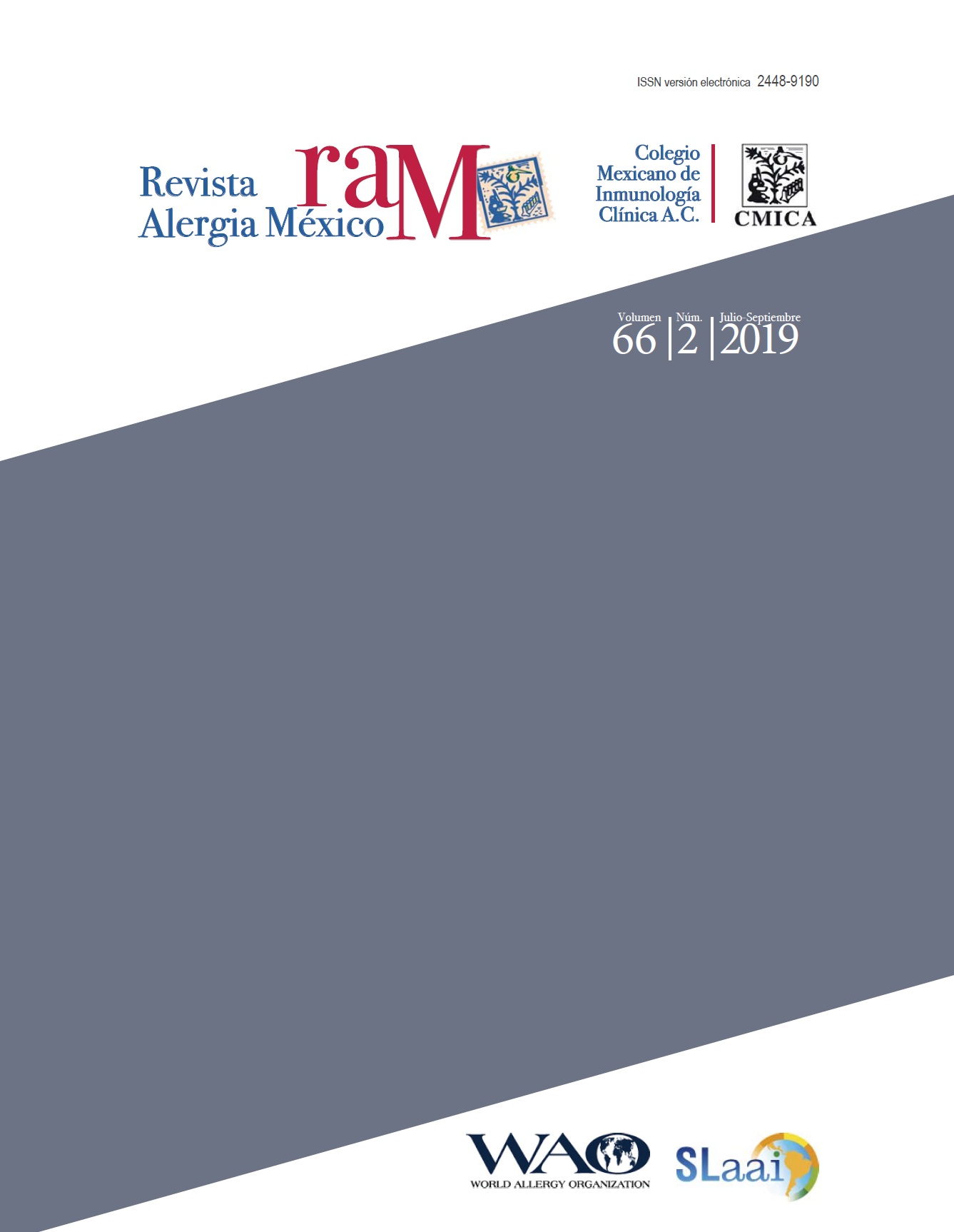Resumen
Antecedentes: La prueba de “helecho” es un método que sirve para evaluar las características de la secreción nasal en el tratamiento de pacientes con disfunción de la mocosa de la vía aérea.
Objetivo: El objetivo del presente estudio fue investigar el papel de la prueba de helecho en pacientes con rinitis y evaluar la clasificación de cada tipo de rinitis (tipos I a IV) en la práctica clínica.
Métodos: Estudio transversal en el que se incluyeron pacientes consecutivos de una unidad de rinología de tercer nivel. Se incluyeron 182 pacientes con rinitis y 30 sujetos sanos como controles. Los pacientes se subdividieron según el tipo de rinitis: alérgica (59), infecciosa (32), pólipos (31), rinitis eosinofílica no alérgica (30) y rinitis no alérgica con neutrófilos (30).
Resultados: Los sujetos control solo presentaron rinitis tipo I o II, mientras que los pacientes con rinitis generalmente mostraban tipo III o IV. La rinitis alérgica y los pólipos nasales tuvieron el deterioro más grave según la prueba de helecho (tipo IV).
Conclusiones: La prueba de helecho es efectiva para evaluar las alteraciones del moco en pacientes con rinitis y podría incluirse como un nuevo parámetro en el estudio de la rinitis como biomarcador potencial de la función de las células epiteliales dañadas.
Referencias
Bansil R, Turner BS. The biology of mucus: composition, synthesis and organization. Adv Drug Deliv Rev. 2018;124:3-15. DOI: 10.1016/j.addr.2017.09.023
Taherali F, Varum F, Basit AW. A slippery slope: on the origin, role and physiology of mucus. Adv Drug Deliv Rev. 2018;124:16-33. DOI: 10.1016/j.addr.2017.10.014
Lang T, Klasson S, Larsson E, Johansson ME, Hansson GC, Samuelsson T. Searching the evolutionary origin of epithelial mucus protein components-mucins and FCGBP. Mol Biol Evol. 2016;33(8):1921-1936. DOI: 10.1093/molbev/msw066
Cone RA. Barrier properties of mucus. Adv Drug Deliv Rev. 2009;61(2):75-85. DOI: 10.1016/j.addr.2008.09.008
Silberberg A. On mucociliary transport. Biorheology. 1990;27(3-4):295-307. DOI: 10.3233/BIR-1990-273-408
Neutra MR, Forstner JF. Gastrointestinal mucus: synthesis, secretion, and function. In: Johnson LR (editor). Physiology of the gastrointestinal tract. EEUU: Raven Press; 1987.
Quraishi MS, Jones NS, Mason J. The rheology of nasal mucus: a review. Clin Otolaryngol Allied Sci. 1998;23(5):403-413. DOI: 10.1046/j.1365-2273.1998.00172.x
Lai SK, Wang YY, Wirtz D, Hanes J. Micro- and macrorheology of mucus. Adv Drug Deliv Rev. 2009;61(2):86-100. DOI: 10.1016/j.addr.2008.09.012
Carlstedt I, Sheehan JK. Structure and macromolecular properties of cervical mucus glycoproteins. Symp Soc Exp Biol. 1989;43:289-316.
Thornton DJ, Sheehan JK. From mucins to mucus: toward a more coherent understanding of this essential barrier. Proc Am Thorac Soc. 2004;1(1):54-61. DOI: 10.1513/pats.2306016
Papanicolaou GN. Mucus test. Anat Rec. 1945;91:293.
Roland M. A simple test for the determination of ovulation, estrogen activity, and early pregnancy using the cervical mucus secretion; a preliminary report. Am J Obstet Gynecol. 1952;63(1):81-89. DOI: 10.1016/S0002-9378(16)38983-9
Zondek B, Rozin S. Cervical mucus arborization; its use in the determination of corpus luteum function. Obstet Gynecol. 1954;3(5):463-470. DOI: 10.1097/00006254-195508000-00049
Abou-Shabanah EH, Plotz EJ. A biochemical study of the cervical and nasal mucus fern phenomenon. Am J Obs Gynecol. 1957;74(3):559-568. DOI: 10.1016/0002-9378(57)90508-2
Rolando M. Tear mucus ferning test in normal and keratoconjunctivitis sicca eyes. Chibret Int J Ophthalmol. 1984;2:33-41.
Rolando M, Baldi F, Zingirian M. The effect of hyperosmolarity on tear mucus ferning. Fortschr Ophthalmol. 1986;83(6):644-646.
Rolando M, Baldi F, Calabria G. Tear mucus crystallization in children with cystic fibrosis. Ophthalmologica. 1988;197(4):202-206. DOI: 10.1159/000309944
Kalayci D, Kiper N, Ozcelik U, Gocmen A, Hasiripi H. Clinical status, ocular surface changes and tear ferning in patients with cystic fibrosis. Acta Ophthalmol Scand. 1996;74(6):563-565. DOI: 10.1111/j.1600-0420.1996.tb00735.x
Horwath J, Ettinger K, Bachernegg M, Bodner E, Schmut O. Ocular Ferning Test - effect of temperature and humidity on tear Ferning patterns. Ophthalmologica. 2001;215(2):102-107. DOI: 10.1159/000050838
Lavaud MC, Trouillas J. The mucus: a medium of life. Gynecol Obstet Fertil. 2012;40(1):19-23. DOI: 10.1016/j.gyobfe.2011.07.031
Gelardi M. Atlas of nasal cytology. Second edition. Milan, Italy: Edi Ermes; 2012.
Gelardi M, Fiorella ML, Russo C, Fiorella R, Ciprandi G. Role of nasal cytology. Int J Immunopathol Pharmacol. 2010;23(Suppl 1):45-49.
Gelardi M, Maselli-Del-Giudice A, Fiorella ML, Fiorella R, Russo C, Soleti P, et al. Non-allergic rhinitis with eosinophils and mast cells constitutes a new severe nasal disorder. Int J Immunopathol Pharmacol. 2008;21(2):325-331. DOI: 10.1177/039463200802100209
Gelardi M, Iannuzzi L, De-Giosa M, Taliente S, DeCandia N, Quaranta N,et al. Non-surgical management of chronic rhinosinusitis with 1 nasal polyps based on clinical cytological grading: a precision medicine-based approach. Acta Otorhinolaryngol Ital. 2017;37(1):38-45. DOI: 10.14639/0392-100X-1417
Rolando M. Tear mucus ferning test in normal and keratoconjunctivitis sicca eyes. Chibret Int J Ophthalmol. 1984;2:32-41.

Esta obra está bajo una licencia internacional Creative Commons Atribución-NoComercial 4.0.
Derechos de autor 2019 Revista Alergia México






